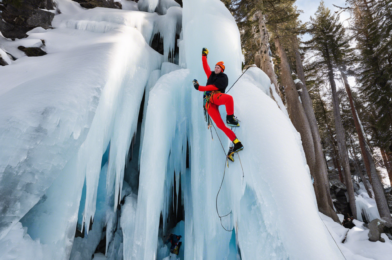As daylight fades, climbers must rely on their headlamps to illuminate the ice and guide their way. It is crucial to ensure that your headlamp is bright enough and has fresh batteries to last the duration of your climb. The beam should be focused and strong enough to light up the ice features and enable you to identify hand and foot placements accurately. Climbing at night also means dealing with colder temperatures, so ensure you have the right clothing to keep warm during your ascent and belays. Layer up with insulated jackets and consider bringing a warm drink in a thermos to help maintain your core temperature.
Route finding is another critical aspect of night ice climbing. In the dark, it can be harder to identify the easiest line or the best resting spots. Take time to study the route in daylight, if possible, and familiarize yourself with any unique features or challenges it may present. Look for landmarks or distinct features that can act as reference points during your climb. Always bring a partner when night climbing, not just for safety but also to provide a second set of eyes to help navigate the route.
Another challenge is accurately assessing ice conditions in the dark. Ice can appear different under artificial light, and it may be harder to identify soft spots or thin sections. Always check the ice conditions before your climb and be prepared to adjust your route or turn back if conditions are unsafe. Bring a variety of ice screws and other protective gear to ensure you can adequately protect the climb and safely establish anchors and belays.
Belaying at night requires extra vigilance and attention. Ensure your belayer is actively engaged and not at risk of falling asleep at the belay station, especially on longer routes or during multi-pitch climbs. Set up the belay station in a comfortable location and bring extra layers or a small bivy sack to help keep the belayer warm and alert. Consider rotating belayers or taking short breaks to ensure everyone stays alert and focused.
Descending in the dark can be just as challenging as climbing up. Familiarize yourself with the descent route beforehand, and bring extra rope and rappelling gear to ensure a safe descent. Mark the descent route with reflective tape or bright markers that can be illuminated by your headlamp, making it easier to find your way back down.
Night ice climbing pushes climbers beyond their comfort zones and presents a unique set of challenges. However, with proper planning, the right equipment, and a vigilant mindset, it can be an incredibly rewarding experience. So, if you’re up for an adventure that takes you off the beaten path, grab your headlamp, some warm layers, and a trusted climbing partner, and embrace the thrill of night ice climbing.
Now, some additional safety tips are worth mentioning to ensure a positive night climbing experience. First and foremost, always climb with a partner and never solo climb, especially at night. Communicate constantly with your partner, ensuring you are both awake, alert, and aware of each other’s actions. It is also a good idea to bring a satellite communication device or a personal locator beacon (PLB) to call for help in emergencies.
Keep your headlamp shining on the climbing surface and avoid pointing it upwards, blinding your partner or other climbers. Bring extra batteries and ensure they are fully charged and stored in a warm pocket to maximize their lifespan in cold temperatures. Additionally, be mindful of the environment and choose climbs away from sensitive wildlife habitats, especially during nesting or breeding seasons. Respect wildlife and natural habitats, and always follow leave-no-trace principles to minimize your impact on the environment.
Night ice climbing is not for the faint-hearted, but for those who embrace the challenge, it offers a unique perspective on the sport. With careful planning, awareness of the risks, and some extra safety precautions, climbers can create unforgettable memories against the backdrop of a starry night sky. So, embrace the adventure, keep safety at the forefront, and enjoy the thrilling experience of climbing ice under the stars.




